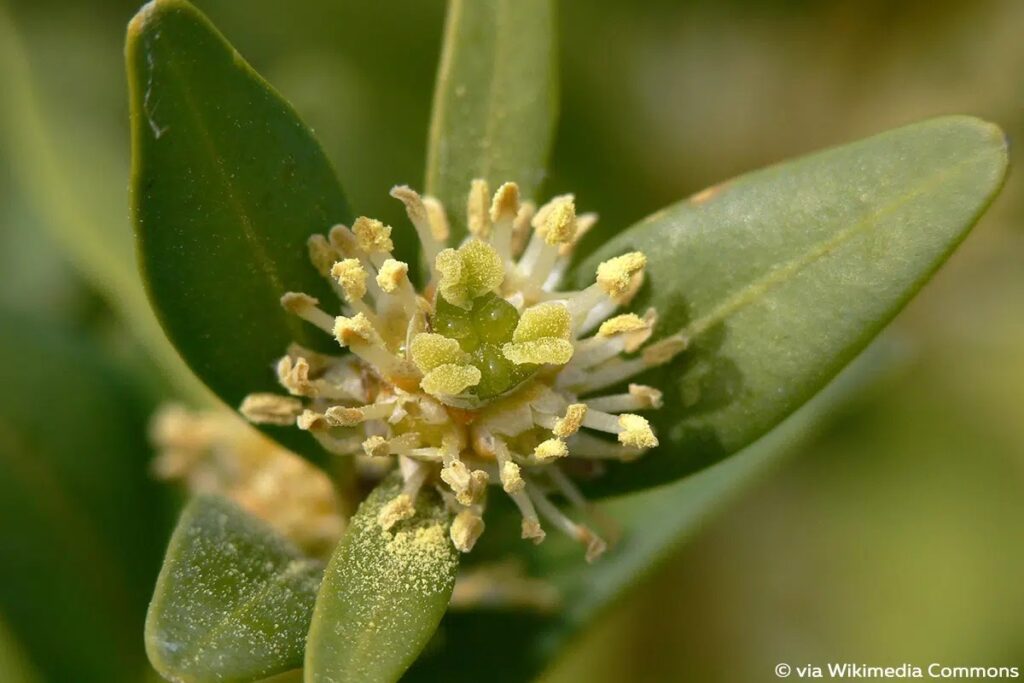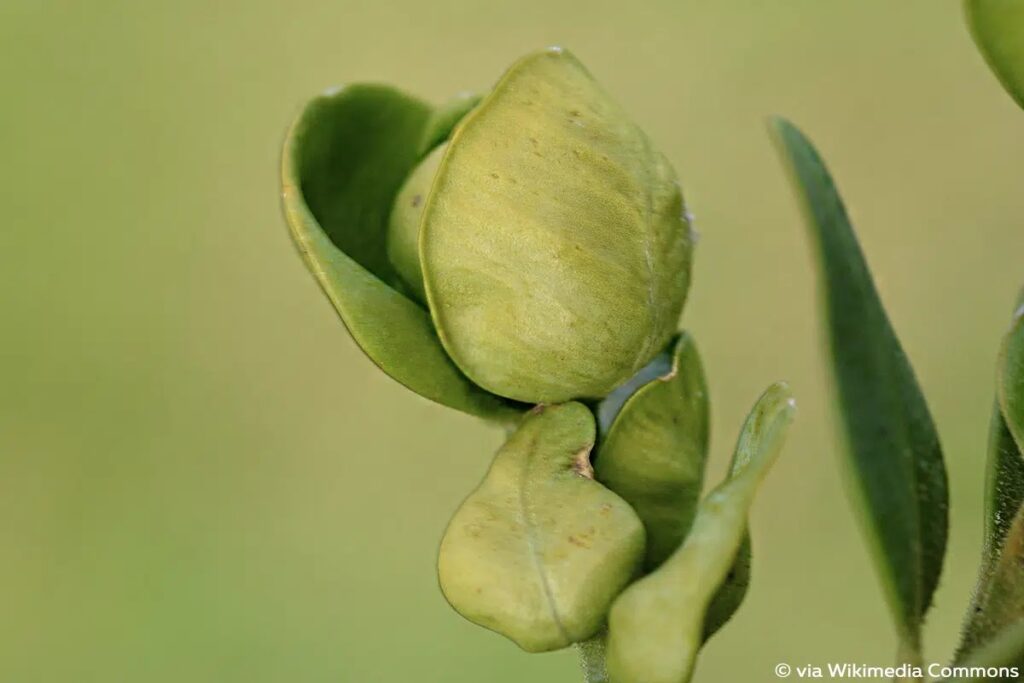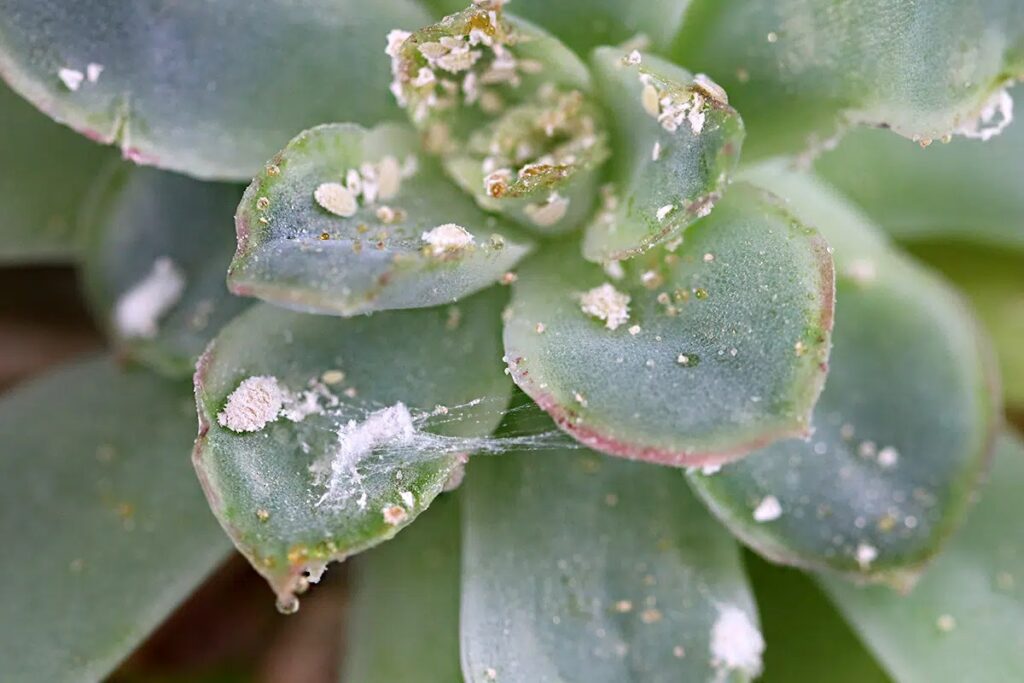Boxwood is a popular woody plant for borders, hedges or as a topiary. However, it is very susceptible to pests and fungi. But not everything that looks like a pest is one.
Contents
- 1 Annual phenomenon in the spring
- 2 Boxwood leaf flea
- 3 Damage
- 4 Combat with soapy water
- 5 By additional pruning
- 6 Neem or rapeseed oil based sprays.
- 7 With pesticides.
- 8 Control
- 9 Frequently asked questions
- 10 What happens if the boxwood leaf flea is not controlled?
- 11 Can pests on boxwood be prevented?
- 12 Are there less susceptible boxwood varieties?
- 13 Author
Annual phenomenon in the spring
White flakes on the boxwood does not necessarily indicate a pest infestation. This phenomenon may also be a completely natural protective mechanism of plants, which occurs every year in the spring after leaf emergence. This occurs regardless of the prevailing weather conditions.

In this way, the plant protects its young, tender, still soft shoot tips. If the leaves increase in size, the waxy, whitish wax sheaths of the young leaves burst open and trickle onto the leaves below. In some cases, they also remain attached to the leaf to be protected for a short time. As soon as it rains, the small flakes disappear very quickly.
Boxwood leaf flea
White flakes on leaves and shoots are often an indication of infestation with insect pests such as the boxwood leaf flea. However, the real danger comes from its voracious larvae.
Damage
In spring, the pest attacks the young shoots on the boxwood. The leaves show bulges upwards and downwards, which resemble the shape of a spoon (spoonleaf). The pests use these to lay eggs in the summer. A closer look reveals white flakes of cotton-wool consistency on the tops of boxwood leaves. In addition, sticky honeydew is found, which in turn can promote the colonization of sooty mold.

Combat with soapy water
The sooner you start with control measures, the more promising they are, especially if you want to use home remedies. Among the home remedies, soap suds have proven to be effective. It is very easy to make.
- You need soap, water and a cloth or sponge.
- Small soap residues or soft soap
- First dissolve soap completely in warm water
- Let the solution cool down
- Soak a cloth or sponge with the solution
- Rub the leaves of the boxwood with it one by one
- Dispose of the water after treatment
- Dispose of the sponge or clean it thoroughly
By additional pruning
- Simplest and most environmentally friendly of all measures
- Advisable if pests or their clutches are detected on the leaves
- Best time is after egg laying, around July or August
- Early cutting out of infested shoot tips can sufficiently decimate infestation
- If this is not sufficient, cut back more
- Do not dispose of cuttings on the compost heap
- It is best to burn them or put them in a sealable foil bag and put them in the household waste.
Neem or rapeseed oil based sprays.
In addition to soap suds, neem or canola oil-based sprays are also said to be very effective. It is best to apply them in the evening hours to prevent sunburn from the liquid droplets on the leaves. You spray infested leaves with it from all sides. These agents gum up the breathing openings of the boxwood leaf flea, causing it to die.
With pesticides.
Chemical agents should always be a last resort. Most of the time they do more harm than good. One also harms native beneficial insects with them. Therefore, these means should always be selected and used with caution, for example, if all other means have not brought the desired success. Since there are no appropriate agents in the specialized trade specifically for the boxwood leaf flea, one must limit oneself to insecticides against sucking insects. These are applied in May against the larvae and from July against the adult pest.
Woolly lice
Woolly aphids owe their name to the white, woolly and greasy hairs. Infestation affects almost all parts of the plant. It starts on the undersides of the leaves and eventually spreads throughout the plant. This pest is one of the sucking insects that can, at worst, cause the boxwood to die.
Damage pattern
Initially, an infestation shows up in yellowed, drying and curled leaves. Shoots and leaves wither, growth is clearly restricted. On the undersides of the leaves, in the leaf axils and branches of the shoots of the boxwood sit white, cotton ball-like flakes, the cocoons, with which the pests protect themselves from predators.

Control
In case of light infestation, spraying with a neem or rapeseed oil based product is recommended. The plant should be sprayed with it until it is dripping wet. The boxwood should then be shaded to protect it from sunburn. If the infestation is severe, more severe pruning is recommended. For specimens in planters, repotting in fresh substrate is recommended.
Frequently asked questions
What happens if the boxwood leaf flea is not controlled?
Total losses are rather not to be feared. However, they will be weakened in the event of a pest infestation, making them more susceptible to other pests.
Can pests on boxwood be prevented?
If you generally avoid using pesticides, you provide a habitat for natural predators so that a massive infestation does not have to occur. Another preventive measure is a light pruning in the fall, which removes the eggs that overwinter on the shoots.
Are there less susceptible boxwood varieties?
The boxwood varieties ‘Herrenhausen’, ‘Blauer Heinz’ and ‘Elegantissima’ are considered less susceptible.









